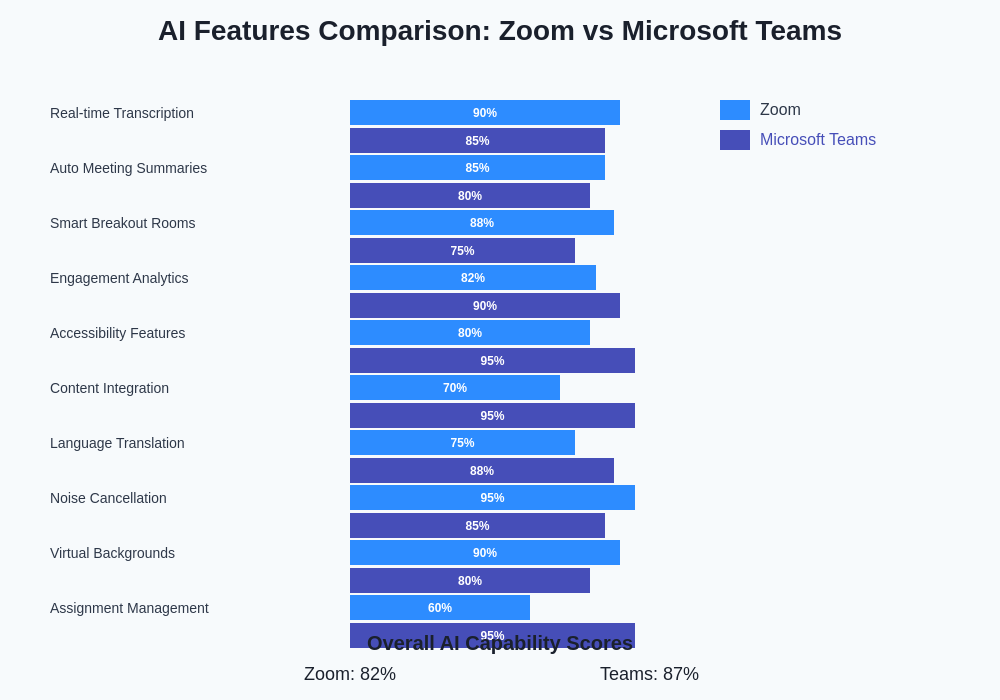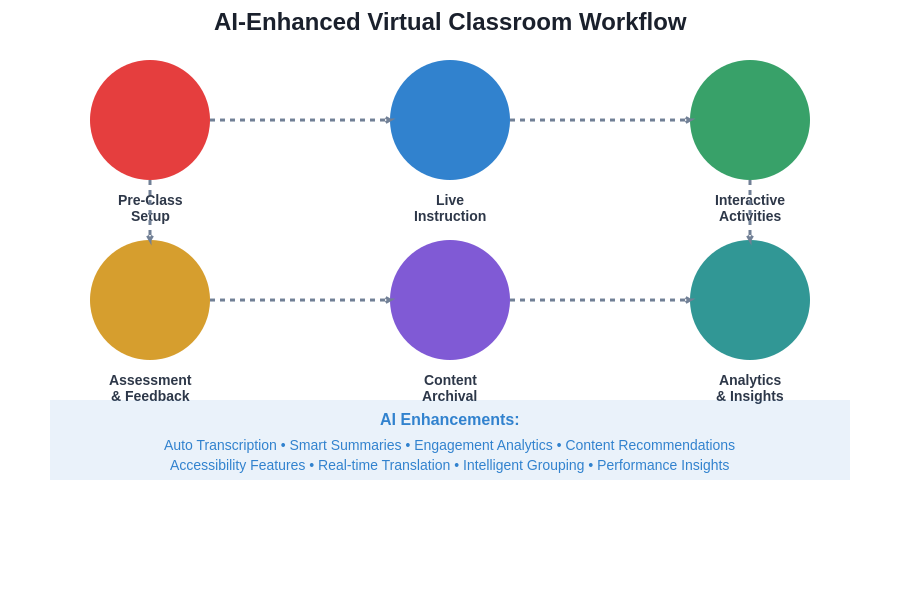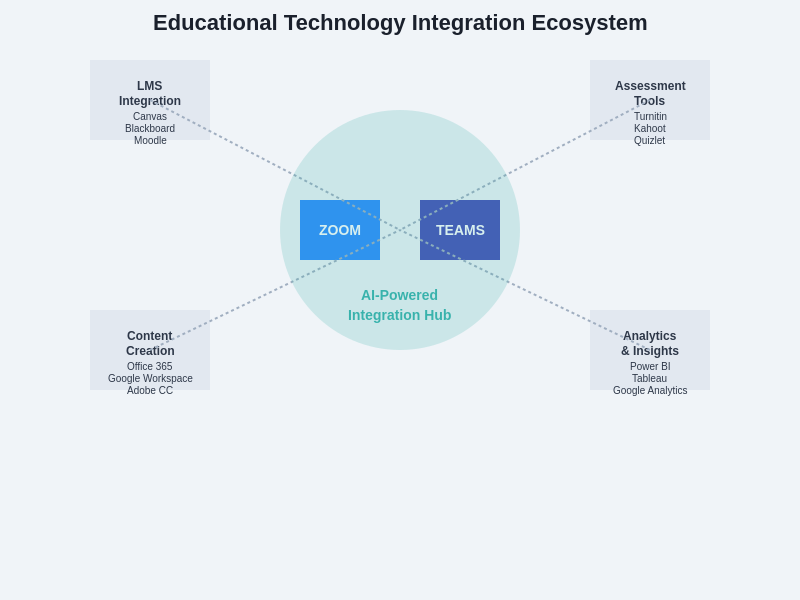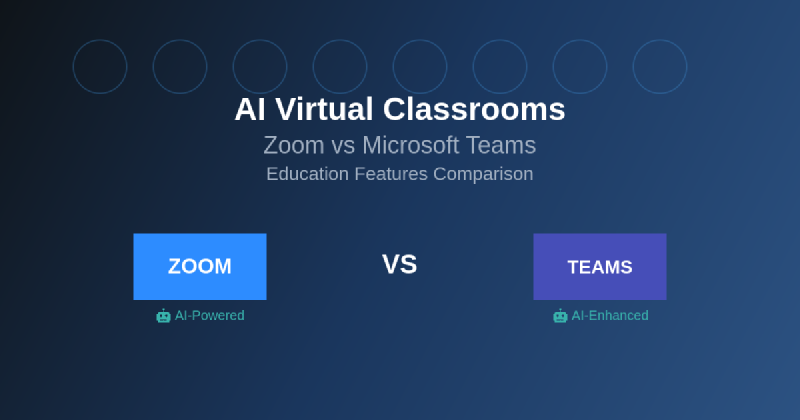The educational landscape has witnessed an unprecedented transformation with the integration of artificial intelligence into virtual classroom platforms, fundamentally reshaping how educators deliver instruction and students engage with learning content. Two industry leaders, Zoom and Microsoft Teams, have emerged as dominant forces in the educational technology space, each offering sophisticated AI-powered features designed to enhance the virtual learning experience and bridge the gap between traditional and digital education environments.
Explore the latest educational AI trends to understand how technology is revolutionizing learning methodologies and classroom dynamics. The evolution of virtual classroom platforms represents a critical juncture in educational history, where artificial intelligence serves not merely as a supplementary tool but as a foundational element that enhances pedagogical effectiveness and student engagement across diverse learning modalities.
The Evolution of AI-Enhanced Virtual Learning
The integration of artificial intelligence into virtual classroom platforms has created unprecedented opportunities for personalized learning experiences, automated administrative tasks, and enhanced student engagement mechanisms. Both Zoom and Microsoft Teams have recognized the transformative potential of AI in education and have developed comprehensive suites of features designed to address the unique challenges faced by educators and students in digital learning environments.
The competitive landscape between these platforms has driven rapid innovation in AI-powered educational tools, resulting in sophisticated solutions that address everything from real-time language translation and automated transcription to intelligent content recommendations and behavioral analytics. This technological arms race has ultimately benefited educational institutions by providing access to increasingly sophisticated tools that enhance learning outcomes while reducing administrative burden on educators.

The comprehensive evaluation of AI capabilities across both platforms reveals distinct strengths and strategic positioning in the virtual education market. While both platforms excel in different areas, the comparative analysis demonstrates the multifaceted nature of AI integration in educational technology and the ongoing evolution of virtual classroom capabilities.
Zoom’s AI-Powered Educational Arsenal
Zoom has strategically positioned itself as a leader in AI-enhanced virtual education through the development of comprehensive features that address critical aspects of digital learning delivery. The platform’s AI Companion serves as a sophisticated assistant that provides real-time support for both educators and students, offering capabilities that extend far beyond traditional video conferencing functionality.
The platform’s intelligent meeting summaries feature automatically generates comprehensive notes and action items from educational sessions, enabling educators to focus entirely on instruction delivery while ensuring that important information is accurately captured and distributed to students. This capability proves particularly valuable for complex subjects where detailed note-taking is essential for student comprehension and retention.
Zoom’s real-time transcription capabilities, powered by advanced natural language processing algorithms, provide immediate accessibility support for students with hearing impairments while simultaneously creating searchable archives of educational content. The accuracy of these transcriptions has improved dramatically through machine learning optimization, making them viable alternatives to human transcription services for most educational applications.
The platform’s breakout room management system utilizes AI algorithms to optimize group formations based on student participation patterns, learning styles, and collaborative preferences. This intelligent grouping mechanism ensures balanced team dynamics and promotes more effective collaborative learning experiences than random assignment methods typically employed in traditional classroom settings.
Enhance your educational workflows with Claude AI for advanced lesson planning, content creation, and student assessment capabilities that complement virtual classroom platforms. The integration of multiple AI tools creates a comprehensive educational ecosystem that supports every aspect of the teaching and learning process.
Microsoft Teams Education AI Innovations
Microsoft Teams Education has leveraged the company’s extensive artificial intelligence research and development capabilities to create a robust educational platform that seamlessly integrates with the broader Microsoft ecosystem. The platform’s AI-powered features are designed to support the entire educational workflow from lesson planning and content delivery to student assessment and progress tracking.
The platform’s Immersive Reader technology represents a significant advancement in accessibility and learning support, utilizing AI to provide real-time reading assistance, language translation, and comprehension support for students with diverse learning needs. This technology adapts to individual reading levels and learning preferences, creating personalized reading experiences that enhance comprehension and retention across various subject areas.
Teams’ intelligent meeting insights feature provides educators with detailed analytics about student engagement, participation patterns, and attention levels during virtual classes. These insights enable data-driven instructional decisions and help educators identify students who may require additional support or intervention to achieve learning objectives.
The platform’s assignment and grading capabilities utilize AI to streamline assessment processes, providing automated feedback on certain types of assignments while identifying potential academic integrity issues. This intelligent assessment system reduces grading time for educators while providing more timely feedback to students, enhancing the overall learning experience.
Microsoft’s integration with educational applications through AI-powered recommendations suggests relevant learning resources, supplementary materials, and collaborative tools based on curriculum requirements and student performance data. This intelligent content curation helps educators discover valuable resources while ensuring alignment with educational objectives and standards.
Comparative Analysis of AI Features
The fundamental differences between Zoom and Microsoft Teams Education AI capabilities reflect their distinct approaches to educational technology integration and user experience optimization. Zoom’s strength lies in its sophisticated video conferencing capabilities enhanced by AI, while Microsoft Teams Education excels in comprehensive ecosystem integration and productivity tool enhancement.
Zoom’s AI features are primarily focused on enhancing the live interaction experience, with sophisticated audio and video processing that automatically adjusts lighting, reduces background noise, and optimizes connection quality for consistent educational delivery. The platform’s virtual background technology and attention tracking capabilities help maintain professional presentation standards while providing insights into student engagement levels.
Microsoft Teams Education’s AI capabilities extend beyond live interactions to encompass the entire educational workflow, including lesson planning, content organization, assignment distribution, and progress tracking. The platform’s deep integration with Microsoft Office applications enables seamless content creation and sharing while providing AI-powered suggestions for improving educational materials and presentations.
Both platforms offer robust accessibility features powered by artificial intelligence, but their implementation approaches differ significantly. Zoom focuses on real-time accessibility support during live sessions, while Microsoft Teams Education provides comprehensive accessibility tools that function across all platform interactions and content types.
Real-Time Communication Enhancement
The quality of real-time communication in virtual classrooms directly impacts educational effectiveness, and both platforms have invested heavily in AI-powered communication enhancement technologies. These innovations address common challenges such as poor audio quality, network connectivity issues, and participant engagement difficulties that can significantly impair learning outcomes.
Zoom’s AI-driven audio processing capabilities automatically filter background noise, enhance speech clarity, and adjust volume levels to ensure consistent audio quality across all participants. The platform’s intelligent bandwidth management adapts video quality based on connection speeds while maintaining optimal audio quality for educational content delivery.
Microsoft Teams Education employs similar audio enhancement technologies while adding sophisticated integration with Microsoft’s cognitive services for real-time language processing and translation capabilities. This integration enables multilingual classroom environments where students can participate in their preferred languages while receiving automatic translation support.
The platforms differ in their approach to visual communication enhancement, with Zoom emphasizing participant visibility and engagement tracking, while Microsoft Teams Education focuses on content sharing optimization and collaborative workspace integration. These different priorities reflect the platforms’ distinct philosophies regarding virtual classroom management and student interaction facilitation.

The AI-enhanced virtual classroom workflow demonstrates the systematic integration of artificial intelligence throughout the educational process, from initial setup and live instruction to assessment and content archival. This comprehensive approach ensures that AI assistance is strategically deployed at every stage to maximize educational effectiveness and streamline administrative processes.
Discover comprehensive AI research capabilities with Perplexity to enhance your understanding of educational technology trends and implementation strategies. The combination of multiple AI-powered research tools provides educators with access to the latest developments in educational methodology and technology integration.
Student Engagement and Analytics
Understanding and measuring student engagement in virtual environments presents unique challenges that both platforms address through sophisticated AI-powered analytics and monitoring systems. These capabilities provide educators with unprecedented insights into student behavior, participation patterns, and learning preferences that inform instructional decision-making.
Zoom’s engagement analytics focus primarily on participation metrics such as speaking time, camera usage, chat participation, and attention tracking through gaze detection algorithms. These metrics provide educators with real-time feedback about student engagement levels and help identify participants who may require additional encouragement or support to maintain active involvement in learning activities.
Microsoft Teams Education offers more comprehensive engagement analytics that extend beyond live session participation to include assignment completion patterns, collaboration frequency, and content interaction behaviors. The platform’s integration with Microsoft’s learning analytics tools provides detailed insights into student progress across multiple educational dimensions and timeframes.
Both platforms utilize machine learning algorithms to identify engagement patterns and provide predictive insights about student performance and participation trends. These predictive capabilities enable proactive intervention strategies that can prevent academic difficulties before they become significant obstacles to learning success.
The ethical considerations surrounding student monitoring and data privacy represent important factors in the implementation of engagement analytics systems. Both platforms have developed comprehensive privacy protection measures and transparent data usage policies to ensure responsible use of student information while maintaining the benefits of AI-powered educational insights.
Accessibility and Inclusive Learning
The commitment to accessibility and inclusive learning represents a fundamental aspect of modern educational technology, and both Zoom and Microsoft Teams Education have developed comprehensive AI-powered accessibility features that ensure equitable access to educational opportunities for students with diverse needs and abilities.
Zoom’s accessibility features include real-time closed captioning with speaker identification, keyboard navigation support, and screen reader compatibility that enables students with visual impairments to participate fully in virtual classroom activities. The platform’s AI-powered captioning system adapts to educational terminology and speaker accents to provide accurate transcription services that support students with hearing difficulties.
Microsoft Teams Education’s accessibility framework encompasses a broader range of assistive technologies, including the Immersive Reader that provides text-to-speech capabilities, syllable breakdown, and visual reading support for students with dyslexia and other reading difficulties. The platform’s AI-powered translation services enable real-time language support for English language learners and international students.
Both platforms support customizable interface options that accommodate different learning preferences and accessibility requirements, including high contrast modes, font size adjustments, and simplified navigation options. These customization capabilities ensure that the technology itself does not create barriers to educational participation and success.
The integration of universal design principles in AI feature development ensures that accessibility enhancements benefit all users rather than serving as separate accommodations. This inclusive approach to technology design creates more effective learning environments for diverse student populations while reducing the stigma associated with assistive technology usage.
Content Management and Organization
Effective content management and organization capabilities represent essential components of successful virtual learning environments, and both platforms have developed sophisticated AI-powered systems for handling educational materials, assignments, and collaborative resources. These systems address the complex challenges of digital content organization while providing intelligent features that enhance educational workflow efficiency.
Zoom’s content management approach focuses primarily on recording and archiving capabilities, with AI-powered features that automatically generate searchable transcripts, identify key topics discussed during sessions, and create time-stamped navigation points for easy content review. The platform’s cloud recording system utilizes machine learning algorithms to optimize storage efficiency while maintaining high-quality educational content accessibility.
Microsoft Teams Education provides comprehensive content management through integration with OneDrive and SharePoint, enhanced by AI-powered organization features that automatically categorize educational materials, suggest relevant resources, and maintain version control for collaborative documents. The platform’s intelligent search capabilities enable quick location of specific content across vast educational resource libraries.
Both platforms offer AI-enhanced content creation tools that assist educators in developing engaging educational materials, with features such as automated slide generation, content suggestion algorithms, and template recommendations based on subject matter and educational objectives. These tools reduce preparation time while helping educators create more effective instructional materials.
The collaborative aspects of content management differ significantly between platforms, with Zoom emphasizing real-time sharing and annotation capabilities, while Microsoft Teams Education focuses on asynchronous collaboration and comprehensive project management features that support extended educational initiatives and group work assignments.
Integration Capabilities and Ecosystem Support
The ability to integrate with existing educational technology ecosystems represents a critical factor in platform selection for educational institutions, and both Zoom and Microsoft Teams Education have developed extensive integration capabilities that enhance their utility within diverse technological environments. These integrations leverage AI to optimize compatibility and functionality across different educational tools and platforms.
Zoom’s integration approach emphasizes compatibility with learning management systems, educational applications, and third-party tools through comprehensive API support and marketplace offerings. The platform’s AI-powered integration recommendations suggest relevant educational tools based on usage patterns and institutional requirements, helping educators discover valuable resources that enhance their virtual classroom capabilities.
Microsoft Teams Education benefits from deep integration with the Microsoft Office suite and extensive third-party application support through the Microsoft app ecosystem. The platform’s AI capabilities extend across integrated applications, providing consistent intelligent features and seamless data sharing that creates a unified educational technology experience.
Both platforms support single sign-on authentication systems and automated user provisioning that simplifies account management for educational institutions while maintaining security standards. These features reduce administrative overhead while ensuring that students and educators can access required tools without technical barriers.
The ecosystem integration capabilities influence the total cost of ownership for educational institutions, with considerations including licensing requirements, training needs, and ongoing maintenance responsibilities. AI-powered management tools help optimize these factors by automating routine tasks and providing intelligent recommendations for system optimization and resource allocation.

The educational technology integration ecosystem illustrates the complex interconnections between virtual classroom platforms and various educational tools and services. This comprehensive integration approach enables seamless data flow and functionality across multiple systems while leveraging AI to optimize compatibility and enhance user experience across the entire educational technology stack.
Security and Privacy Considerations
Educational institutions face unique security and privacy challenges when implementing virtual classroom technologies, particularly regarding student data protection and compliance with educational privacy regulations. Both Zoom and Microsoft Teams Education have developed comprehensive security frameworks enhanced by AI-powered threat detection and privacy protection mechanisms.
Zoom’s security approach includes end-to-end encryption for educational sessions, AI-powered anomaly detection for identifying potential security threats, and comprehensive access controls that ensure only authorized participants can join educational sessions. The platform’s privacy features include automatic removal of personal information from recordings and intelligent data retention policies that comply with educational privacy regulations.
Microsoft Teams Education leverages Microsoft’s enterprise-grade security infrastructure, including advanced threat protection, intelligent security analytics, and automated compliance monitoring that helps educational institutions maintain regulatory compliance while protecting student information. The platform’s AI-powered security features continuously monitor for suspicious activities and provide real-time threat mitigation.
Both platforms offer granular privacy controls that enable educational institutions to customize data handling practices according to their specific requirements and regulatory obligations. These controls include options for data residency, retention periods, and sharing permissions that ensure appropriate protection of sensitive educational information.
The implementation of AI-powered security features raises important considerations about algorithmic transparency and decision-making accountability in educational contexts. Both platforms have developed explainable AI frameworks that provide visibility into security decisions while maintaining the effectiveness of automated threat detection and response systems.
Cost Analysis and Value Proposition
The economic considerations surrounding virtual classroom platform selection involve complex analyses of direct costs, implementation expenses, training requirements, and long-term value creation for educational institutions. Both Zoom and Microsoft Teams Education offer different pricing models and value propositions that reflect their distinct approaches to educational technology delivery.
Zoom’s education pricing structure emphasizes scalability and flexibility, with AI-powered usage analytics that help institutions optimize licensing costs based on actual usage patterns and feature requirements. The platform’s transparent pricing model enables accurate budget planning while providing access to advanced AI features at competitive rates for educational institutions.
Microsoft Teams Education is often bundled with broader Microsoft licensing agreements, creating potential cost advantages for institutions already invested in the Microsoft ecosystem. The platform’s AI capabilities are integrated into comprehensive productivity suites, potentially reducing the need for additional specialized software while providing extensive educational functionality.
Both platforms offer free tiers with limited AI capabilities for educational use, enabling institutions to evaluate platform suitability before committing to paid subscriptions. These trial opportunities are essential for understanding how AI features translate into practical educational benefits and improved learning outcomes.
The total cost of ownership calculations must include considerations such as staff training requirements, technical support needs, and ongoing maintenance responsibilities. AI-powered administrative tools on both platforms help reduce these indirect costs by automating routine tasks and providing intelligent management recommendations that optimize resource utilization.
Future Developments and Innovation Trajectories
The competitive landscape between Zoom and Microsoft Teams Education continues to drive rapid innovation in AI-powered educational technology, with both platforms investing heavily in advanced capabilities that will shape the future of virtual learning environments. Understanding these development trajectories helps educational institutions make informed decisions about long-term technology investments.
Zoom’s innovation roadmap emphasizes advanced AI capabilities such as emotion recognition for enhanced engagement analytics, predictive modeling for identifying at-risk students, and automated content generation tools that assist educators in creating personalized learning materials. The platform’s research initiatives focus on creating more intuitive and responsive virtual classroom experiences that adapt to individual learning preferences and needs.
Microsoft Teams Education benefits from Microsoft’s broader AI research initiatives, including developments in conversational AI, advanced language processing, and intelligent tutoring systems that promise to transform educational content delivery and student support mechanisms. The platform’s integration with Microsoft’s cognitive services enables rapid deployment of cutting-edge AI capabilities as they become available.
Both platforms are exploring immersive technologies such as virtual reality and augmented reality integration, powered by AI systems that create realistic and engaging educational experiences. These developments promise to bridge the gap between virtual and physical learning environments while providing new opportunities for experiential and collaborative learning.
The evolution of AI-powered educational assessment tools represents another significant development area, with both platforms working on sophisticated systems that provide real-time feedback, adaptive testing capabilities, and comprehensive learning analytics that support personalized educational pathways and improved learning outcomes.
Implementation Strategies and Best Practices
Successful implementation of AI-powered virtual classroom platforms requires careful planning, comprehensive training programs, and strategic change management approaches that help educational institutions maximize the benefits of advanced educational technology while minimizing disruption to existing educational processes and workflows.
The implementation process should begin with thorough assessment of institutional needs, existing technology infrastructure, and educational objectives to determine which platform features align most closely with specific requirements. Both Zoom and Microsoft Teams Education offer comprehensive consultation services and implementation support that leverage AI-powered analysis to optimize platform configuration for individual institutional contexts.
Training programs for educators and students represent critical success factors in platform adoption, with both platforms providing AI-enhanced learning resources that adapt to individual skill levels and learning preferences. These personalized training approaches help accelerate platform adoption while ensuring that users can effectively utilize advanced AI features to enhance educational outcomes.
Change management strategies should address potential resistance to technology adoption while highlighting the specific benefits that AI-powered features provide for educational effectiveness and efficiency. Successful implementation requires ongoing support systems and continuous evaluation of platform effectiveness in achieving educational objectives and improving learning outcomes.
The monitoring and evaluation of AI feature utilization provides valuable insights for optimizing platform configuration and identifying opportunities for enhanced educational technology integration. Both platforms offer comprehensive analytics tools that help institutions assess the impact of AI-powered features on student engagement, learning outcomes, and educational efficiency.
The future of virtual education lies in the intelligent integration of AI-powered tools that enhance rather than replace human expertise and creativity in educational delivery. Both Zoom and Microsoft Teams Education represent sophisticated solutions that leverage artificial intelligence to create more effective, accessible, and engaging learning environments that prepare students for success in an increasingly digital world.
Disclaimer
This article is for informational purposes only and does not constitute professional advice regarding educational technology selection or implementation. The features and capabilities described are based on current platform offerings and may change over time. Educational institutions should conduct thorough evaluations of their specific requirements and consult with technology specialists before making platform selection decisions. The effectiveness of AI-powered educational tools may vary depending on institutional context, user adoption rates, and implementation quality.
